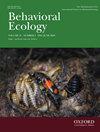Housework or vigilance? Bilbies alter their burrowing activity under threat of predation by feral cats
IF 2.5
3区 环境科学与生态学
Q2 BEHAVIORAL SCIENCES
引用次数: 0
Abstract
Abstract Behavioral adjustments to predation risk not only impose costs on prey species themselves but can also have cascading impacts on whole ecosystems. The greater bilby (Macrotis lagotis) is an important ecosystem engineer, modifying the physical environment through their digging activity, and supporting a diverse range of sympatric species that use its burrows for refuge and food resources. The bilby has experienced a severe decline over the last 200 years, and the species is now restricted to ~20% of its former distribution. Introduced predators, such as the feral cat (Felis catus), have contributed to this decline. We used camera traps to monitor bilby burrows at four sites in Western Australia, where bilbies were exposed to varying levels of cat predation threat. We investigated the impact of feral cats on bilby behavior at burrows, particularly during highly vulnerable periods when they dig and clear away soil or debris from the burrow entrance as they perform burrow maintenance. There was little evidence that bilbies avoided burrows that were visited by a feral cat; however, bilbies reduced the time spent performing burrow maintenance in the days following a cat visit (P = 0.010). We found the risk posed to bilbies varied over time, with twice the cat activity around full moon compared with dark nights. Given bilby burrows are an important resource in Australian ecosystems, predation by feral cats and the indirect impact of cats on bilby behavior may have substantial ecosystem function implications.家务还是警惕?兔耳袋狸在野猫捕食的威胁下改变了它们的挖洞活动
对捕食风险的行为调整不仅会给被捕食物种本身带来成本,而且会对整个生态系统产生连锁影响。大兔耳袋狸(Macrotis lagotis)是一个重要的生态系统工程师,通过它们的挖掘活动来改变物理环境,并支持各种同域物种利用其洞穴作为避难所和食物资源。兔耳袋狸在过去的200年里经历了严重的衰退,现在该物种的分布范围被限制在以前的20%左右。引入的掠食者,如野猫(Felis catus),导致了这种下降。我们在西澳大利亚的四个地点使用相机陷阱来监测兔耳袋狸的洞穴,在那里兔耳袋狸暴露于不同程度的猫捕食威胁中。我们调查了野猫对兔耳袋狸在洞穴中的行为的影响,特别是在高度脆弱的时期,当它们在洞穴入口处挖掘和清理土壤或碎片时,它们进行洞穴维护。几乎没有证据表明兔耳袋狸会避开野猫光顾的洞穴;然而,兔耳袋狸在猫来访后的几天内减少了进行洞穴维护的时间(P = 0.010)。我们发现兔耳袋狸面临的风险随着时间的推移而变化,满月前后的猫活动是黑夜的两倍。鉴于兔耳袋狸洞穴是澳大利亚生态系统的重要资源,野猫的捕食和猫对兔耳袋狸行为的间接影响可能对生态系统功能产生重大影响。
本文章由计算机程序翻译,如有差异,请以英文原文为准。
求助全文
约1分钟内获得全文
求助全文
来源期刊

Behavioral Ecology
环境科学-动物学
CiteScore
5.20
自引率
8.30%
发文量
93
审稿时长
3.0 months
期刊介绍:
Studies on the whole range of behaving organisms, including plants, invertebrates, vertebrates, and humans, are included.
Behavioral Ecology construes the field in its broadest sense to include 1) the use of ecological and evolutionary processes to explain the occurrence and adaptive significance of behavior patterns; 2) the use of behavioral processes to predict ecological patterns, and 3) empirical, comparative analyses relating behavior to the environment in which it occurs.
 求助内容:
求助内容: 应助结果提醒方式:
应助结果提醒方式:


